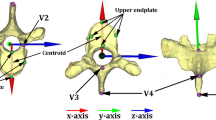Abstract
The lumbar shape in females is thought to be unique, compensating for lumbar hyperlordosis. Yet, the morphological adaptation of various vertebral parameters in the thoracic and lumbar spine to this unique posture in young and adult females has only been partially addressed in the literature. Our aim was to investigate the gender association to vertebral shape in the thoracic and lumbar spine as a possible adaptation to lumbar hyperlordosis in young and adult females. A three-dimensional digitizer was used to measure the vertebral body sagittal wedging, relative spinous process thickness, and relative interfacet width at the T1–L5 level. Two hundred and forty complete, non-pathological skeletons of adults and 32 skeletons of young individuals were assessed. Three major results were found to be independent of age and ethnicity: (a) VB sagittal wedging in females was significantly less kyphotic than males from T9 to L2 (T11 excluded) with a cumulative mean difference of 8.8°; (b) females had a significantly relatively thinner lumbar spinous processes and (c) females had a relatively wider superior interfacet distance (T9–T10 and L1–L4) than males. We conclude that the combination of less kyphotic VB wedging in the lower thoracic and upper lumbar vertebrae, relatively greater interspinous space and larger interfacet width in the lumbar spine in females are key architectural elements in the lumbar hyperlordosis in females and may compensate for the bipedal obstetric load during pregnancy.




Similar content being viewed by others
References
Bergenudd H, Nilsson B, Uden A, Willner S (1989) Bone mineral content, gender, body posture, and build in relation to back pain in middle age. Spine 14:577–579
Dunlop R, Adams A, Hutton W (1984) Disc space narrowing and the lumbar facet joints. J Bone Joint Surg Br 66:706–710
Lorenz M, Patwardhan A, Vanderby R (1983) Load-bearing characteristics of lumbar facets in normal and surgically altered spinal segments. Spine 8:122–130
Love T, Fagan A, Fraser R (1999) Degenerative spondylolisthesis: developmental or acquired? J Bone Joint Surg Br 81:670–674
Masharawi Y, Rothschild B, Dar G, Peleg S, Been E, Robinson D, Hershkovitz I (2004) Facet orientation in the thoraco-lumbar spine: three-dimensional anatomical and biomechanical analysis. Spine 29:1755–1763
Masharawi Y, Rothschild B, Salame K, Dar G, Peleg S, Hershkovitz I (2005) Facet tropism and interfacet shape in the thoraco-lumbar spine: characterization and biomechanical interpretation. Spine 30:E281–E292
Masharawi Y, Alperovitch-Najenson D, Dar G, Peleg S, Steinberg N, Rothschild R, Salame K, Hershkovitz I (2007) Lumbar facet orientation in spondylolysis: a skeletal study. Spine 32:E176–E180
Masharawi Y, Kjaer P, Bendix T, Manniche C, May H, Mirovski Y, Anekshtein Y, Jensen TS, Hershkovitz I (2009) Lumbar facet and interfacet shape variation during growth in boys and girls from the general population: a three years MRI follow-up study. Spine 15:408–412
Masharawi Y, Dar G, Peleg S, Steinberg N, Alperovitch-Najenson D, Salame K, Hershkovitz I (2007) Lumbar facet anatomy changes in spondylolysis: a comparative skeletal study. Eur Spine J 16:993–999
Norton B, Sahrmann S, Van Dillen L (2004) Differences in measurements of lumbar curvature related to gender and low back pain. J Orth Sports Phys Ther 34:524–534
Parent S, Labelle H, Skalli W, Latimer B, de Guise J (2002) Morphometric analysis of anatomic scoliotic specimens. Spine 27:2305–2311
Sanderson P, Fraser R (1996) The Influence of pregnancy on the development of degenerative spondylolisthesis. J Bone Joint Surg 78:951–954
Scoles P, Latimer B, DigIovanni B, Vargo E, Bauza S, Jellema L (1991) Vertebral alterations in Scheuermann’s kyphosis. Spine 16:509–515
Tanner JM (1990) Fetus into man: physical growth from conception to maturity, 6th edn. Cambridge, MA, pp 165–171
Taylor J, Twomey L (1984) Sexual dimorphism in human vertebral body shape. J Anat 138:281–286
Whitcome K, Shapiro L, Lieberman D (2007) Fetal load and the evolution of lumbar lordosis in bipedal hominins. Nature 450:1075–1078
Youdas J, Garett T, Harmsen W, Suman V, Carey J (1996) Lumbar lordosis and pelvic inclination of asymptomatic adults. Phy Ther 76:1066–1081
Acknowledgments
The authors wish to thank Phyllis Curchack Kornspan for her editorial and secretarial services.
Author information
Authors and Affiliations
Corresponding author
Rights and permissions
About this article
Cite this article
Masharawi, Y., Dar, G., Peleg, S. et al. A morphological adaptation of the thoracic and lumbar vertebrae to lumbar hyperlordosis in young and adult females. Eur Spine J 19, 768–773 (2010). https://doi.org/10.1007/s00586-009-1256-6
Received:
Revised:
Accepted:
Published:
Issue Date:
DOI: https://doi.org/10.1007/s00586-009-1256-6




